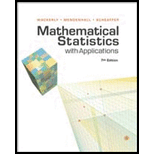
a.
Calculate the values of
a.
Answer to Problem 78E
The value of
The value of
Explanation of Solution
Calculation:
Consider that
Then, the marginal probability
In the given problem
Hence, using the joint probability distribution the marginal probability distribution of
Thus, the marginal density function for
Similarly, using the joint probability distribution the marginal probability distribution of
Thus, the marginal density function for
The expectation of
Thus, the value of
The expectation of
Thus, the value of
b.
Calculate the values of
b.
Answer to Problem 78E
The value of
The value of
Explanation of Solution
Calculation:
The variance of any random variable,
Now,
Thus, the variance is calculated below:
Thus, the value of
Now,
Thus, the variance is calculated below:
Thus, the value of
c.
Find the value of
c.
Answer to Problem 78E
The value of
Explanation of Solution
Calculation:
For any two random variables,
Thus, using the values obtained in Part a, the value of
d.
Calculate the value of
Give the
d.
Answer to Problem 78E
The value of
The values of
Explanation of Solution
Calculation:
The value of
Now, using the values obtained in Parts b and c, it can be said that,
The calculation of
Thus,
Thus, the value of
Tchebysheff’s theorem:
According to Tchebysheff’s theorem discussed in Exercise 1.32, the fraction of observations lying within the interval
For the 2-standard deviations interval about the mean,
In this case,
The interval
About 75% of the scores must fall in the above interval.
Hence, most of the values of
Want to see more full solutions like this?
Chapter 5 Solutions
Mathematical Statistics with Applications
- Algebra & Trigonometry with Analytic GeometryAlgebraISBN:9781133382119Author:SwokowskiPublisher:Cengage
 Elementary Linear Algebra (MindTap Course List)AlgebraISBN:9781305658004Author:Ron LarsonPublisher:Cengage Learning
Elementary Linear Algebra (MindTap Course List)AlgebraISBN:9781305658004Author:Ron LarsonPublisher:Cengage Learning Linear Algebra: A Modern IntroductionAlgebraISBN:9781285463247Author:David PoolePublisher:Cengage Learning
Linear Algebra: A Modern IntroductionAlgebraISBN:9781285463247Author:David PoolePublisher:Cengage Learning  Elementary Geometry For College Students, 7eGeometryISBN:9781337614085Author:Alexander, Daniel C.; Koeberlein, Geralyn M.Publisher:Cengage,
Elementary Geometry For College Students, 7eGeometryISBN:9781337614085Author:Alexander, Daniel C.; Koeberlein, Geralyn M.Publisher:Cengage, Elements Of Modern AlgebraAlgebraISBN:9781285463230Author:Gilbert, Linda, JimmiePublisher:Cengage Learning,
Elements Of Modern AlgebraAlgebraISBN:9781285463230Author:Gilbert, Linda, JimmiePublisher:Cengage Learning, Elementary Geometry for College StudentsGeometryISBN:9781285195698Author:Daniel C. Alexander, Geralyn M. KoeberleinPublisher:Cengage Learning
Elementary Geometry for College StudentsGeometryISBN:9781285195698Author:Daniel C. Alexander, Geralyn M. KoeberleinPublisher:Cengage Learning





